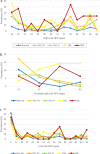Type distribution of human papillomaviruses in ThinPrep cytology samples and HPV16/18 E6 gene variations in FFPE cervical cancer specimens in Fars province, Iran
- PMID: 37568237
- PMCID: PMC10422805
- DOI: 10.1186/s12935-023-03011-8
Type distribution of human papillomaviruses in ThinPrep cytology samples and HPV16/18 E6 gene variations in FFPE cervical cancer specimens in Fars province, Iran
Abstract
Background: There exists strong evidence that human papillomavirus (HPV) is associated with cervical cancer (CC). HPV E6 is a major oncogene whose sequence variations may be associated with the development of CC. There is not sufficient data on the distribution of HPV types in ThinPrep cytology specimens and HPV 16/18 E6 gene variations among CC patients in the southwest of Iran. This study was conducted to contribute to HPV screening and vaccination in Iran.
Methods: A total of 648 women screened for cervicitis, intraepithelial neoplasia or CC were included in the study. All participants underwent ThinPrep cytology testing, single-step HPV DNA detection and allele-specific reverse hybridization assays. Moreover, a total of 96 specimens previously tested positive for single infection with HPV16 or 18 were included for variant analysis. HPV16/18 lineages and sublineages were determined by PCR assays followed by sequencing the E6 gene and the construction of neighbor-joining phylogenetic trees.
Results: Overall, HPV DNA was detected in 62.19% of all the screened subjects. The detection rates of HPV DNA among individuals with normal, ASC-US, ASC-H, LSIL, and HSIL cervical cytology were 48.9%, 93.6%, 100%, 100%, and 100%, respectively. Low-risk HPVs were detected more frequently (46.9%) than high-risk (38.9%) and possible high-risk types (11.1%). Of 403 HPV-positive subjects, 172 (42.7%) had single HPV infections while the remaining 231 (57.3%) were infected with multiple types of HPV. Our results indicated a remarkable growth of high-risk HPV66 and 68 and low-risk HPV81 which have rarely been reported in Iran and HPV90 and 87 that are reported for the first time in the country. In addition, 3 lineages (A, D, and C) and 6 sublineages (A1, A2, A4, C1, D1, and D2) of HPV16, and one lineage and 4 sublineages (A1, A3, A4, and A5) of HPV18 were identified. The studied HPV16 and 18 variants mainly belonged to the D1 and A4 sublineages, respectively.
Conclusion: The present study suggests that the prevalence of HPV infection in women of all age groups with or without premalignant lesions in the southwestern Iran is high and the predominant HPV types in the southwest of Iran may differ from those detected in other parts of the country. This study also highlights the necessity of not only initiating HPV vaccination for the general population but also developing new vaccines that confer immunity against the prevalent HPV types in the area and national cervical screening programs using a combination of thinPrep cytology test and HPV detection assays in order to improve the accuracy of the screening.
Keywords: Cervical cancer; HPV; HPV16; HPV18; Lineage; Phylogenetic analysis; ThinPrep.
© 2023. BioMed Central Ltd., part of Springer Nature.
Conflict of interest statement
The authors declare that they have no competing interests.
Figures




Similar articles
-
The frequency of high-risk human papillomavirus types, HPV16 lineages, and their relationship with p16INK4a and NF-κB expression in head and neck squamous cell carcinomas in Southwestern Iran.Braz J Microbiol. 2021 Mar;52(1):195-206. doi: 10.1007/s42770-020-00391-1. Epub 2020 Nov 9. Braz J Microbiol. 2021. PMID: 33169334 Free PMC article.
-
Performance of carcinogenic human papillomavirus (HPV) testing and HPV16 or HPV18 genotyping for cervical cancer screening of women aged 25 years and older: a subanalysis of the ATHENA study.Lancet Oncol. 2011 Sep;12(9):880-90. doi: 10.1016/S1470-2045(11)70188-7. Epub 2011 Aug 22. Lancet Oncol. 2011. PMID: 21865084 Clinical Trial.
-
Liquid-based cytology--new possibilities in the diagnosis of cervical lesions.Coll Antropol. 2010 Mar;34(1):19-24. Coll Antropol. 2010. PMID: 20432728
-
HPV16 Phylogenetic Variants in Anogenital and Head and Neck Cancers: State of the Art and Perspectives.Viruses. 2024 Jun 3;16(6):904. doi: 10.3390/v16060904. Viruses. 2024. PMID: 38932197 Free PMC article. Review.
-
Evidence regarding human papillomavirus testing in secondary prevention of cervical cancer.Vaccine. 2012 Nov 20;30 Suppl 5:F88-99. doi: 10.1016/j.vaccine.2012.06.095. Vaccine. 2012. PMID: 23199969 Review.
Cited by
-
The Lineage and Sublineage Investigation of Human Papillomavirus Type 16 in Tehran, Iran, During 2022-2023: A Cross-Sectional Study.Health Sci Rep. 2025 May 5;8(5):e70680. doi: 10.1002/hsr2.70680. eCollection 2025 May. Health Sci Rep. 2025. PMID: 40330748 Free PMC article.
-
HPV Infections-Classification, Pathogenesis, and Potential New Therapies.Int J Mol Sci. 2024 Jul 11;25(14):7616. doi: 10.3390/ijms25147616. Int J Mol Sci. 2024. PMID: 39062859 Free PMC article. Review.
References
-
- Sung H, Ferlay J, Siegel RL, Laversanne M, Soerjomataram I, Jemal A, et al. Global Cancer Statistics 2020: GLOBOCAN Estimates of Incidence and Mortality Worldwide for 36 Cancers in 185 Countries. CA Cancer J Clin. 2021;71(3):209–249. - PubMed
-
- Rezaianzadeh A, Dehghani SL, Mousavi M, Rezaeianzadeh R. The incidence of uterus cancer in Iran: a systematic review. WHB. 2017;4(1):1–4.
-
- Schledermann D, Ejersbo D, Hoelund B. Improvement of diagnostic accuracy and screening conditions with liquid-based cytology. Diagn Cytopathol. 2006;34(11):780–785. - PubMed
LinkOut - more resources
Full Text Sources
Miscellaneous

